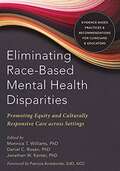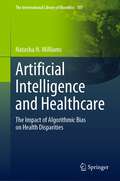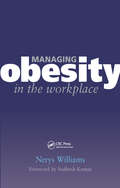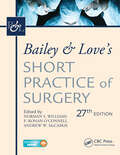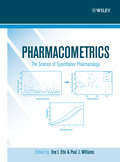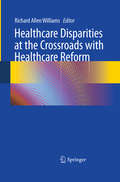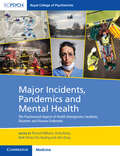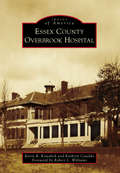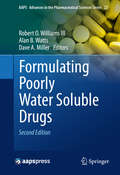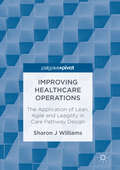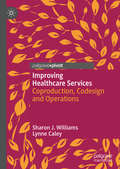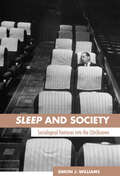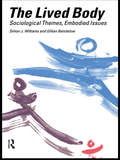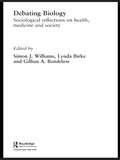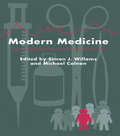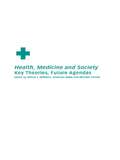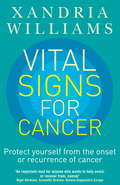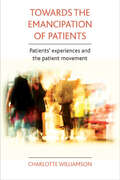- Table View
- List View
Eliminating Race-based Mental Health Disparities: Promoting Equity And Culturally Responsive Care Across Settings
by Monnica T. Williams Daniel C. Rosen Jonathan W. KanterEliminating Race-Based Mental Health Disparities offers concrete guidelines and evidence-based best practices for addressing racial inequities and biases in clinical care. Perhaps there is no subject more challenging than the intricacies of race and racism in American culture. More and more, it has become clear that simply teaching facts about cultural differences between racial and ethnic groups is not adequate to achieve cultural competence in clinical care. One must also consider less “visible” constructs—including implicit bias, stereotypes, white privilege, intersectionality, and microaggressions—as potent drivers of behaviors and attitudes. In this edited volume, three leading experts in race, mental health, and contextual behavior science explore the urgent problem of racial inequities and biases, which often prevent people of color from seeking mental health services—leading to poor outcomes if and when they do receive treatment. In this much-needed resource, you’ll find evidence-based recommendations for addressing problems at multiple levels, and best practices for compassionately and effectively helping clients across a range of cultural groups and settings. As more and more people gain access to services that have historically been unavailable to them, guidelines for cultural competence in clinical care are needed. Eliminating Race-Based Mental Health Disparities offers a comprehensive road map to help you address racial health disparities and improve treatment outcomes in your practice.
Artificial Intelligence and Healthcare: The Impact of Algorithmic Bias on Health Disparities (The International Library of Bioethics #107)
by Natasha H. WilliamsThis book explores the ethical problems of algorithmic bias and its potential impact on populations that experience health disparities by examining the historical underpinnings of explicit and implicit bias, the influence of the social determinants of health, and the inclusion of racial and ethnic minorities in data. Over the last twenty-five years, the diagnosis and treatment of disease have advanced at breakneck speeds. Currently, we have technologies that have revolutionized the practice of medicine, such as telemedicine, precision medicine, big data, and AI. These technologies, especially AI, promise to improve the quality of patient care, lower health care costs, improve patient treatment outcomes, and decrease patient mortality. AI may also be a tool that reduces health disparities; however, algorithmic bias may impede its success. This book explores the risks of using AI in the context of health disparities. It is of interest to health services researchers, ethicists, policy analysts, social scientists, health disparities researchers, and AI policy makers.
Managing Obesity in the Workplace: Turning Tyrants into Tools in Health Practice, Book 3
by Nerys Williams Griselda Cooper"Managing Obesity in the Workplace" comprehensively examines how obesity impacts business and provides examples of action that can be taken by employers to prevent weight gain and facilitate weight loss in their staff. A considered, evidence-based analysis of the extent of the obesity problem reveals how this public health epidemic affects all workplaces influencing fitness to work, sickness absence, discrimination and bullying.Case studies from around the world clearly illustrate the extent of the problem and offer practical, innovative and budget friendly solutions for all businesses, large and small. With a focus on nutrition, physical activity, motivation and education, this book is ideal for occupational health professionals, public health and primary care doctors and nurses, health and safety officers, and nutritionists and dieticians. Organisations promoting workplace health, including sports/exercise equipment suppliers, will find it enlightening reading, as will business owners and managers.
Bailey and Love's Short Practice of Surgery (27th Edition): The Collector�s edition
by Norman Williams P Ronan O'Connell Andrew McCaskieBailey & Love is the world famous textbook of surgery. Its comprehensive coverage includes the scientific basis of surgical practice, investigation, diagnosis, and pre-operative care. Trauma and Orthopaedics are included, as are the subspecialties of plastic and reconstructive, head and neck, cardiothoracic and vascular, abdominal and genitourinary surgery. The user-friendly format includes photographs, line diagrams, learning objectives, summary boxes, biographical footnotes, memorable anecdotes and full-colour page design. This book's reputation for unambiguous advice make it the first point of reference for student and practising surgeons worldwide.
Pharmacometrics
by Paul J. Williams Ene I. EttePharmacometrics is the science of interpreting and describing pharmacology in a quantitative fashion. The pharmaceutical industry is integrating pharmacometrics into its drug development program, but there is a lack of and need for experienced pharmacometricians since fewer and fewer academic programs exist to train them. Pharmacometrics: The Science of Quantitative Pharmacology lays out the science of pharmacometrics and its application to drug development, evaluation, and patient pharmacotherapy, providing a comprehensive set of tools for the training and development of pharmacometricians.Edited and written by key leaders in the field, this flagship text on pharmacometrics:Integrates theory and practice to let the reader apply principles and concepts.Provides a comprehensive set of tools for training and developing expertise in the pharmacometric field.Is unique in including computer code information with the examples.This volume is an invaluable resource for all pharmacometricians, statisticians, teachers, graduate and undergraduate students in academia, industry, and regulatory agencies.
Blacks in Medicine: Clinical, Demographic, and Socioeconomic Correlations
by Richard Allen WilliamsThis socially conscious, culturally relevant book explores the little-known history and present climate of Black people in the medical field. It reveals the deficiencies in the American healthcare structure that have contributed to the mismanagement of healthcare in the Black population, and examines cross-currents that intersect with the major events in minority medical history. Illustrated across 10 expertly written chapters, this text features a longitudinal timeline with the presentation of evidence-based information drawn from historical, political, and clinical sources. The book begins with an analysis of diseases particularly prevalent in the Black community due to socioeconomic inequalities in available medical care. These diseases include sickle cell anemia, hypertension, heart failure, drug addiction, and HIV/AIDS. Bolstered by profiles of historically well-known Black physicians, stories of success in medical education, and the remarkable impact of Black medical organizations, subsequent chapters address the triumphs and tribulations of the Black medical professional in America. Concluding with an examination of the current health status of Black people in the United States, the book makes a case for future systemic improvements in healthcare delivery to minority communities. A unique, noteworthy reference, Blacks in Medicine: Clinical, Demographic, and Socioeconomic Correlations is written for a broad range of physicians and health providers, as well as professionals in the social sciences and public health.
Healthcare Disparities at the Crossroads with Healthcare Reform
by Richard Allen WilliamsBuilding upon the success of Dr. Williams's widely influential book Eliminating Healthcare Disparities in America: Beyond the IOM Report, this new volume takes a fresh and timely look at the state of healthcare reform and the progress and problems we face in the pursuit of healthcare equality. This book focuses on how the elimination of disparities can be accomplished through targeted efforts made within the context of reform. Comprising the combined efforts of the nation's best health policy analysts, researchers, key opinion leaders and clinicians, this book addresses both current and impending legislation and future movements in healthcare. With the knowledge that the problem of disparities extends beyond the present political arena into the larger scope of all aspects of healthcare delivery, the authors provide critical analysis of the causation of disparities, insightful examples of what has worked, and a striking call to action with implementable strategies for advancing equality.
Major Incidents, Pandemics and Mental Health: The Psychosocial Aspects Of Health Emergencies, Incidents, Disasters And Disease Outbreaks
by Richard Williams Verity Kemp Keith Porter Tim Healing John DruryEssex County Overbrook Hospital (Images of America)
by Robert L. Williams Kevin R. Kowalick Kathryn CataldoWhat was founded as the Essex County Lunacy Asylum evolved from a single building on South Orange Avenue to a city within itself in Cedar Grove. It was named the Essex County Overbrook Hospital. Construction began on the hospital's iconic brick buildings in 1896, and they were prominent features on Fairview Avenue for the next 100 years. The facility produced its own food, housed its own police and fire departments, and sustained its own power sources. The Essex County Overbrook Hospital was recognized throughout the world as a leader in psychiatric care. In later years, overcrowding began to plague the institution. However, after the advent of modern psychiatric drugs, many patients were able to be discharged back into the community. In 2007, the buildings were closed, and the hospital was relocated to a newer establishment nearby. The grounds have since been plagued with vandalism and neglect, with a final deal for demolition having been solidified in 2015.
Formulating Poorly Water Soluble Drugs
by Robert O. Williams Alan B. Watts Dave A. MillerThe objective of this volume is to consolidate within a single text the most current knowledge, practical methods, and regulatory considerations pertaining to formulations development with poorly water-soluble molecules. A pharmaceutical scientist's approach toward solubility enhancement of a poorly water-soluble molecule typically includes detailed characterization of the compound's physiochemical properties, solid-state modifications, advanced formulation design, non-conventional process technologies, advanced analytical characterization, and specialized product performance analysis techniques. The scientist must also be aware of the unique regulatory considerations pertaining to the non-conventional approaches often utilized for poorly water-soluble drugs. One faced with the challenge of developing a drug product from a poorly soluble compound must possess at minimum a working knowledge of each of the abovementioned facets and detailed knowledge of most. In light of the magnitude of the growing solubility problem to drug development, this is a significant burden especially when considering that knowledge in most of these areas is relatively new and continues to develop
Clinical Dilemmas in Non-Alcoholic Fatty Liver Disease
by Roger Williams Simon D. Taylor-RobinsonClinical Dilemmas in Non-Alcoholic Fatty Liver Disease offers hepatologists practical, up-to-date and expert guidance on the most topical dilemmas, difficulties and areas of controversy/difficulty surrounding this ever-increasing area of liver disease they face in daily practice. Roger Williams and Simon Taylor-Robinson, two of Europe's leading hepatologists, have recruited leading figures from across the world to assist them, resulting in a truly international approach. Each chapter covers a specific area of difficulty, containing clear learning points and providing evidence-based expert guidance on the latest hot topics in clinical management such as: Is NAFLD different in absence of Metabolic Syndrome? Are the pros outweighed by the cons of obtaining a liver biopsy? Is progression to cirrhosis more likely in children with NAFLD? What are the dangers as well as the true benefits of bariatric surgery? How is it best to use antifibrotic agents in clinical practice? Clinical Dilemmas in Non-Alcoholic Fatty Liver Disease provides the answers to the questions and challenges that clinicians face every day in this area. It is essential reading for hepatologists of all levels and researchers in hepatology, as well as all those involved in the care of patients with NAFLD, including gastroenterologists, pathologists and specialist hepatology nurses.
Clinical Dilemmas in Primary Liver Cancer (Clinical Dilemmas (UK) #6)
by Roger Williams Simon D. Taylor-RobinsonClinical Dilemmas in Liver Cancer follows the successful format of the other books in the Clinical Dilemmas series, with each chapter focused on a specific dilemma, or issue facing doctors in their day-to-day job, and providing them with practical clinical information and help to better assessment and treat their patients – in this case patients suffering from liver cancer, the third commonest cancer in terms of mortality worldwide. Chapters feature up-to-date information on the basic mechanisms, epidemiological risk factors, screening and surveillance strategies, diagnosis and treatment. It is an extremely practical and clinically-orientated book, and as most patients around the world present with advanced disease, a main focus is on the most recent advances allowing early diagnosis and use of locoregional and systemic therapy, surgery, transplantation and combination therapies. Each chapter is authored by an international expert in the relevant area.
Field-Flow Fractionation in Biopolymer Analysis
by S. Kim Williams Karin D. CaldwellThis is a timely collection of important biomedical applications for a set of separation/characterization techniques that are rapidly gaining popularity due to their wide dynamic range, high resolution, and ability to function in most commonly used solvent systems. Importantly, the field-flow fractionation (FFF) technique has recently emerged as a prominent complement to size exclusion chromatography for protein pharmaceuticals. Fractionation with FFF is gentle and preserves protein structural integrity better than existing alternatives. In the present text, different chapters are written by experts in their respective field of application, who offer comparisons between the FFF techniques and other methods for characterizing their special focus material. Practical guide-lines for successful implementation, such as choice of operating conditions, are offered in conjunction with each application. In addition to new instrumentation and approaches that address important current topics, readers are provided with an overall sense of prior (but timeless) major developments that may be overlooked in literature searches.
Improving Healthcare Operations
by Sharon J WilliamsThis book examines the design of two care pathways to establish how key principles associated with systems thinking, quality improvement, and supply chain management can improve the design of these services. 'Lean' has typically been the prominent approach when improving the design of healthcare systems and is often selected by healthcare professionals to standardize and improve the delivery of care. Previous literature shows there has been varying success in the application of 'Lean', the author presents a study which examines the benefits of introducing 'Agile' as an alternative and complementary approach. Improving Healthcare Operations explores when 'Lean' and 'Agile' are most applicable, and instances where a hybrid approach can be employed. Including empirical qualitative data collected from two care pathways, it intends to provide organizations with an alternative in order to produce the level and quality of care that is expected by patients.
Improving Healthcare Services: Coproduction, Codesign and Operations
by Sharon J. Williams Lynne CaleyBuilding on co-author Sharon Williams’ previous title Improving Healthcare Operations, this book examines the role of co-design and coproduction in health and social care. Extending current thinking on coproduction in healthcare and how this can be operationalised, this book opens a discussion around how it can contribute to improvement. Providing a number of case studies, it links previous public service management, operations management and supply chain management research by extending and translating these core design and improvement principles into health and social care. Considering the wider role of patients, communities and other stakeholders it will challenge and develop existing thinking in relation to co-design, coproduction and redesign of services.
Chronic Respiratory Illness (Experience Of Illness Ser.)
by Simon J. WilliamsChronic obstructive airways disease (COAD: bronchitis, emphysema and chronic asthma) is a major medical, psychological, social and economic problem. Breathlessness is one of the most distressing and disabling symptoms of COAD, and it has long been apparent that the condition results in impaired quality of life. Drawing upon sociological and psychological sources, and his own detailed research in this area, Simon Williams sesitively portrays the meaning, experience and impact of COAD. Sufferers' and their families' own accounts are used to portray the various stages and aspects of COAD, ranging from the experience of symptoms and the management of medical regimens, to the practical problems it creates in daily life and the more diffuse and intangible ways in which it impinges on social and family life. He also provides a comprehensive review of the psychosocial literature and concludes by discussing some of the policy implications for health care professionals.
Sleep and Society: Sociological Ventures into the Un(known)
by Simon J. WilliamsExploring the sociological aspects of sleep and their links to current health debates, this unique text discusses why sleep has been so neglected in sociological literature and examines significant modern issues such as: the 24-hour society sleep and work homelessness dream analysis the medicalization and commodification of sleep. Written by a key international figure in medical sociology, this is the first sociological examination of sleep, making it important reading for academics and advanced students of medical sociology, health studies, and sociology, as well as for professionals and policy makers involved in the area.
The Lived Body: Sociological Themes, Embodied Issues
by Simon J. Williams Gillian A. BendelowThe Lived Body takes a fresh look at the notion of human embodiment and provides an ideal textbook for undergraduates on the growing number of courses on the sociology of the body.The authors propose a new approach - an 'Embodied Sociology' - one which makes embodiment central rather than peripheral. They critically examine the dualist legacies of the past, assessing the ideas of a range of key thinkers, from Marx to Freud, Foucault to Giddens, Deleuze to Guattari and Irigary to Grosz, in terms of the bodily themes and issues they address.They also explore new areas of research, including the 'fate' of embodiment in late modernity, sex, gender, medical technology and the body, the sociology of emotions, pain, sleep and artistic representations of the body.The Lived Body will provide students and researchers in medical sociology, health sciences, cultural studies and philosophy with clear, accessible coverage of the major theories and debates in the sociology of the body and a challenging new way of thinking.
Debating Biology
by Simon J. Williams Lynda Birke Gillian A. BendelowRelations between the biological and social sciences have been hotly contested and debated over the years. The uses and abuses of biology, not least to legitimate or naturalize social inequalities and to limit freedoms, have rightly been condemned. All too often, however the style of debate has been reductionist and ultimately unfruitful. As we enter an age in which ultr-Darwinian forms of explanation gather momentum and the bio-tech revolution threatens a 'Brave New World' of possibilities, there is urgent need to re-open the dialogue and rethink these issues in more productive ways. Debating Biology takes a fresh look at the relationship between biology and society as it is played out in the arena of health and medicine. Bringing together contributions from both biologists and sociologists, the book is divided into five themed sections:- Theorising Biology draws on a range of critical perspectives to discuss the case or 'bringing back' the biological into sociology.- Structuring Biology focuses on the interplay between biological and social factors in the 'patterning' of health and illness.- Embodying Biology examines the relationship between the lived body and the biological body- Technologizing Biology takes up the multiple relations between biology, science and technology.- Reclaiming Biology looks at the broader ethical and political agendas.Written in an accessible and engaging style, this timely volume will appeal to a wide audience within and beyond the social sciences, including students, lecturers and researchers in health and related domains.
Modern Medicine: Lay Perspectives And Experiences
by Simon J. Williams Michael CalnanDo lay people view modern medicine as a fountain of hope or a font of despair? What are their experiences of modern medical care and technology, and how do their views and experiences differ across different social groups? Combining theoretical insights with a range of qualitative and ethnographic research, this volume examines lay experiences and evaluation of medicines and drugs, chronic illness and life-saving technology, and reproductive technologies. It also considers the growing popularity of complementary therapies as a potential challenge to orthodox medicine.
Health, Medicine and Society: Key Theories, Future Agendas
by Simon J. Williams Jonathan Gabe Michael CalnanTaking as its point of departure recent developments in health and social theory Health, Medicine and Society brings together a range of eminent, international scholars to reflect upon key issues at the turn of the century. Contributors draw upon a range of contemporary theories, both modernist and postmodernist, to look at the following themes: *health and social structure*the contested nature of the body*the salience of consumption and risk*the challenge of emotions Health, Medicine and Society provides a 'state-of-the-art' assessment of health related issues at the millennium and a cogent set of arguments for the centrality of health to contemporary social theory. Written in a clear, accessible style it will be ideal reading for students and researchers in health studies, public health, medical sociology, medicine and nursing.
The Pox and the Covenant
by Tony WilliamsFor one hundred years, God had held to his promise, and the colonists had as well. When the first Puritans sailed into Massachusetts in the seventeenth century, weak from the ocean journey, they formed a covenant with each other and with God to establish a city on a hill-a commitment to live uncorrupted lives together or all suffer divine wrath for their collective sin. But now, a century later, the arrival of one doomed ship would put this covenant to its greatest test. On April 22, 1721, the HMS Seahorse arrived in Boston from the West Indies, carrying goods, cargo, and, unbeknownst to its crew, a deadly virus. Soon, a smallpox epidemic had broken out in Boston, causing hundreds of deaths and panic across the city. The clergy, including the famed Cotton Mather, turned to their standard form of defense against disease: fasting and prayer. But a new theory was also being offered to the public by the scientific world: inoculation. The fierce debate over the right way to combat the tragedy would become a battle between faith and reason, one that would set the city aflame with rage and riot. The Pox and the Covenant is a story of well known figures such as Cotton Mather, James Franklin, and a young Benjamin Franklin struggling to fight for their cause among death and debate-although not always for the side one would expect. In the end, the incredible results of the epidemic and battle would reshape the colonists' view of their destiny, setting for America a new course, a new covenant, and the first drumbeats of revolution.
The Doctor Stories
by William Carlos Williams William Eric Williams Atul GawandeA new edition of one of the best books ever written about being a doctor: writing as aware and memorable as Chekhov’s. The Doctor Stories collects thirteen of Williams’s stories (direct accounts of his experiences as a doctor), six related poems, and a chapter from his autobiography that connects the world of medicine and writing, as well as a new preface by Atul Gawande, an introduction by Robert Coles (who put the book together), and a final note by Williams’s son (also a doctor), about his famous father. The writings are remarkably direct and freshly true. As Atul Gawande notes, “Reading these tales,you find yourself in a conversation with Williams about who people really are—who you really are. Williams recognized that, caring for the people of his city, he had a front-row seat to the human condition. His writing makes us see it and hear it and grapple with it in all its complexities. That is his lasting gift.”
Vital Signs For Cancer: How to prevent, reverse and monitor the cancer process
by Xandria WilliamsIn VITAL SIGNS, Xandria Williams explains why current medical treatments for cancer are having so little effect. She draws on her research findings, scientific background and work as a nutritionist and naturopath specialising in cancer to help you to understand the cancer process and give expert advice on how you can detect and reverse the cancer process long before a tumour appears. She gives accessible and practical advice on how to avoid cancer and monitor good health, what to do if you are afraid you may have cancer or be at risk of developing cancer, and complementary and alternative (CAM) approaches to follow if you currently have cancer or have just been diagnosed. These can be used safely alongside medical treatment. She also advises on how you can remain cancer free if you are in remission and want to avoid a recurrence.
Towards the emancipation of patients: Patients' experiences and the patient movement
by Charlotte WilliamsonDespite a policy focus on involving patients in health care and increasing patient autonomy, much covert coercion of patients takes place in everyday healthcare. This book, by a leading patient activist, examines for the first time how the patient movement, which works to improve the quality of healthcare, can actually be considered an emancipation movement when led by its radical elements. In this highly original book the author argues that radical patient groups and individual activists who repeatedly challenge or oppose some standards in healthcare, can be seen as working in the direction of freeing patients from coercion and from its associated injustice and inequality. Combining new academic theory with rich empirical evidence, the book explains how looking at healthcare from an emancipatory perspective could improve its quality as patients experience it. It will appeal to health professionals, managers, patient activists, policy makers and others concerned with the quality of healthcare.
